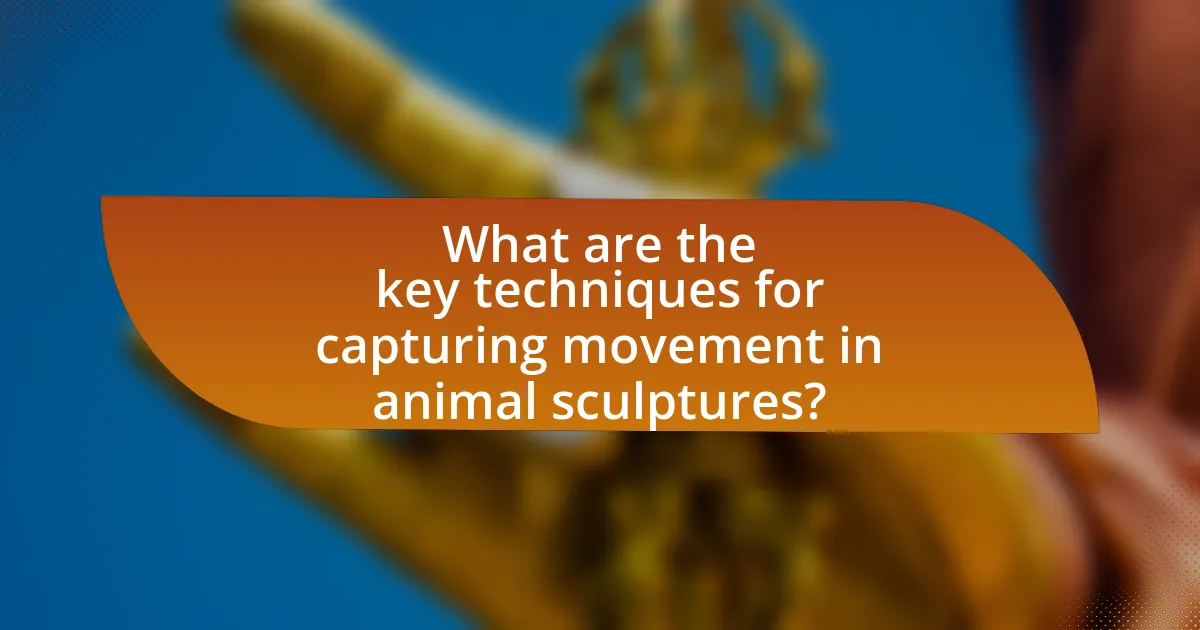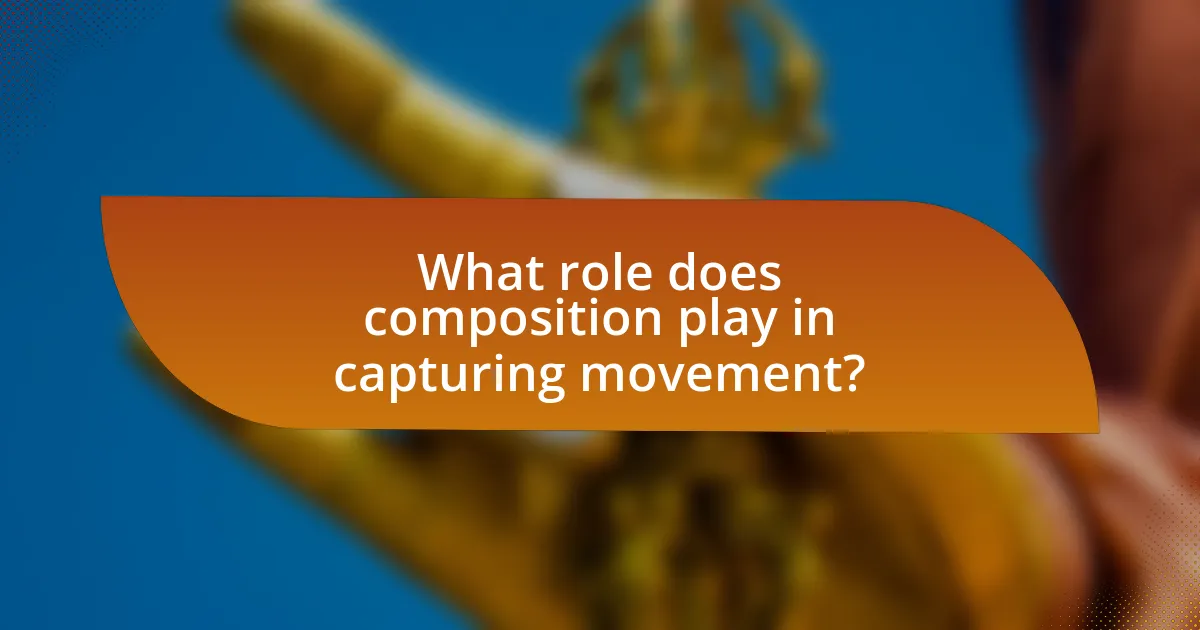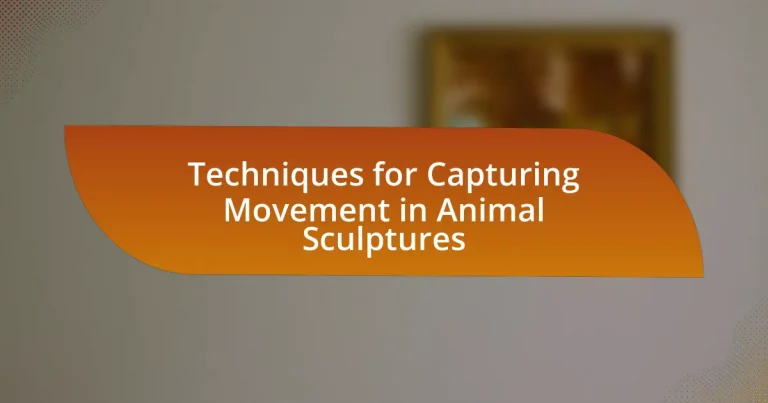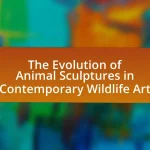The article focuses on techniques for capturing movement in animal sculptures, emphasizing the importance of dynamic poses, fluid lines, and textural details. It explores how artists convey motion through careful anatomical understanding, material selection, and compositional strategies. Key aspects include the influence of pose on movement perception, the role of negative space, and the impact of lighting and texture on the illusion of speed. Additionally, the article addresses common challenges artists face in representing movement and offers practical tips for improving their work.

What are the key techniques for capturing movement in animal sculptures?
The key techniques for capturing movement in animal sculptures include dynamic poses, fluid lines, and textural details. Dynamic poses involve positioning the animal in a way that suggests action, such as a leap or a run, which can be achieved through careful study of the animal’s anatomy and movement patterns. Fluid lines enhance the sense of motion by creating a visual flow that guides the viewer’s eye, often using curves and angles that mimic the natural movement of the animal. Textural details, such as the representation of fur or feathers, can also convey movement by suggesting the way these materials react during motion, adding realism and vitality to the sculpture. These techniques are supported by the principles of kinetic art, which emphasize the importance of movement in visual representation.
How do artists convey motion in their sculptures?
Artists convey motion in their sculptures through techniques such as dynamic poses, flowing lines, and the use of materials that suggest movement. Dynamic poses capture the essence of action, allowing viewers to perceive the energy and intent of the subject. Flowing lines, often seen in the contours of the sculpture, guide the eye and create a sense of rhythm and fluidity. Additionally, materials like bronze or marble can be manipulated to enhance the illusion of movement, as seen in works by artists like Alberto Giacometti, whose elongated figures evoke a sense of urgency and motion. These methods collectively enable artists to create a visual narrative that embodies motion, engaging the viewer’s imagination and perception.
What materials are best suited for depicting movement?
The best materials for depicting movement in animal sculptures are clay, bronze, and wire. Clay allows for detailed modeling and can capture dynamic poses effectively, as seen in the works of artists like Edgar Degas, who used it to create fluid forms. Bronze, through the lost-wax casting process, provides durability and can convey a sense of motion through its surface texture and patina, exemplified in the sculptures of Alberto Giacometti. Wire is versatile for creating lightweight, abstract representations of movement, enabling artists to manipulate shapes easily, as demonstrated in the kinetic sculptures of Alexander Calder. These materials collectively enhance the representation of movement by allowing for intricate details, durability, and flexibility in form.
How does the choice of pose influence the perception of movement?
The choice of pose significantly influences the perception of movement in animal sculptures by conveying dynamic energy and directionality. A pose that suggests tension or extension, such as a leaping or running stance, creates an impression of motion, engaging the viewer’s imagination to visualize the action. Research indicates that specific body angles and limb positioning can evoke different interpretations of speed and agility; for instance, a forward-leaning posture often implies acceleration. This is supported by studies in visual perception, which show that viewers are more likely to perceive movement in sculptures that utilize poses mimicking real-life animal locomotion, enhancing the overall realism and emotional impact of the artwork.
Why is understanding animal anatomy important for movement representation?
Understanding animal anatomy is crucial for movement representation because it enables accurate depiction of how animals move based on their skeletal and muscular structures. Knowledge of anatomy allows artists and sculptors to create lifelike representations that reflect the natural dynamics of movement, ensuring that the positioning of limbs, the curvature of the spine, and the overall posture are true to the species being represented. For instance, studies in biomechanics reveal that the way an animal’s muscles and joints interact directly influences its movement patterns, which is essential for artists aiming to capture realistic motion in sculptures.
What anatomical features should artists focus on to depict movement accurately?
Artists should focus on the joints, muscles, and overall body posture of the animal to depict movement accurately. The joints, such as elbows, knees, and hips, are crucial as they determine the range of motion and the angles at which limbs can move. Muscles provide the necessary tension and relaxation that convey dynamic movement, while the body posture reflects the animal’s intent and action, whether it is running, jumping, or resting. For instance, a study on animal locomotion highlights that understanding the biomechanics of these anatomical features allows artists to create more lifelike representations, as accurate depictions of muscle groups and joint positions can significantly enhance the perception of movement in sculptures.
How can knowledge of animal behavior enhance the sculpture’s dynamism?
Knowledge of animal behavior can enhance a sculpture’s dynamism by allowing the artist to accurately depict movement and posture that reflect the natural actions of the animal. Understanding how animals move, interact, and express emotions enables sculptors to create pieces that resonate with viewers, making the artwork feel alive. For instance, studies in ethology, the science of animal behavior, reveal specific postures and movements associated with different emotions or actions, such as a dog in play or a bird in flight. By incorporating these insights, artists can produce sculptures that not only capture the physical form but also convey the essence of the animal’s behavior, resulting in a more engaging and dynamic representation.

What role does composition play in capturing movement?
Composition plays a crucial role in capturing movement by arranging elements within a sculpture to guide the viewer’s eye and convey a sense of dynamism. Effective composition utilizes lines, shapes, and balance to create an illusion of motion, allowing the viewer to perceive the energy and action of the subject. For instance, the use of diagonal lines can suggest speed and direction, while asymmetrical balance can evoke tension and anticipation, enhancing the overall impression of movement. This technique is supported by the principles of visual perception, which indicate that our brains interpret certain arrangements as indicative of motion, thus reinforcing the sculpture’s intended narrative.
How can the arrangement of elements affect the sense of motion?
The arrangement of elements in animal sculptures significantly influences the viewer’s perception of motion. By strategically positioning limbs, body angles, and facial expressions, artists can create a dynamic composition that suggests movement. For instance, a sculpture depicting a galloping horse with extended legs and a lowered head conveys speed and energy, while a crouched position may imply readiness to pounce, suggesting potential motion. This technique aligns with principles of design, such as the use of diagonal lines, which naturally evoke a sense of action and direction. Studies in visual perception indicate that viewers are more likely to interpret arrangements that mimic natural movement patterns as dynamic, reinforcing the effectiveness of these artistic choices in conveying motion.
What are the principles of dynamic composition in sculpture?
The principles of dynamic composition in sculpture focus on creating a sense of movement and energy within a static form. These principles include balance, rhythm, contrast, and unity, which work together to engage the viewer and convey action. For instance, balance ensures that the sculpture feels stable while still suggesting motion, while rhythm can be achieved through repeated forms or lines that guide the viewer’s eye. Contrast highlights differences in texture or form, enhancing the dynamic quality, and unity ties all elements together, creating a cohesive piece that effectively captures the essence of movement.
How does the use of negative space contribute to the illusion of movement?
The use of negative space enhances the illusion of movement by creating a dynamic relationship between the subject and its surroundings. Negative space, defined as the area around and between the main subjects of an artwork, can suggest direction and flow, guiding the viewer’s eye and creating a sense of action. For instance, in animal sculptures, strategically placed negative space can imply motion by suggesting where the animal is moving towards or away from, thus reinforcing the perception of kinetic energy. This technique is supported by principles of visual perception, where the brain interprets the absence of form as an indication of movement, allowing artists to convey a sense of liveliness and fluidity in their work.
What techniques can be used to create a sense of speed in sculptures?
To create a sense of speed in sculptures, artists can employ techniques such as dynamic poses, elongated forms, and the use of lines or textures that suggest motion. Dynamic poses capture the moment of action, allowing viewers to perceive the energy and movement of the subject. Elongated forms can exaggerate the physical characteristics of the subject, enhancing the impression of rapid movement. Additionally, incorporating lines or textures that radiate from the sculpture can visually imply speed, guiding the viewer’s eye along the direction of motion. These techniques are supported by principles of visual perception, where the human eye interprets certain shapes and arrangements as indicative of movement, thus reinforcing the sense of speed in the artwork.
How do lines and shapes influence the perception of speed?
Lines and shapes significantly influence the perception of speed by creating visual cues that suggest motion. For instance, diagonal lines often convey a sense of dynamism and rapidity, while curved shapes can imply fluidity and acceleration. Research in visual perception indicates that the orientation and arrangement of lines can lead viewers to interpret the speed of an object; for example, a series of parallel lines trailing behind a figure can enhance the illusion of swift movement. This principle is utilized in art and design, where artists manipulate these elements to evoke a sense of speed in sculptures, particularly in representations of animals in motion.
What are some examples of successful speed representation in animal sculptures?
Successful speed representation in animal sculptures can be seen in works such as Alberto Giacometti’s “Walking Man” and Edgar Degas’ “Little Dancer Aged Fourteen.” Giacometti’s sculpture captures the essence of movement through elongated forms and dynamic poses, suggesting the act of walking with a sense of urgency. Degas’ work, on the other hand, effectively conveys the fluidity of motion in ballet through the dancer’s poised stance and intricate detailing of the limbs, emphasizing grace and speed. Both artists utilize techniques such as exaggerated proportions and careful attention to posture to evoke a sense of rapid movement, demonstrating their mastery in representing speed in sculpture.

How can lighting and texture enhance the depiction of movement?
Lighting and texture significantly enhance the depiction of movement by creating dynamic contrasts and emphasizing surface details. Effective lighting can cast shadows and highlights that suggest motion, making the sculpture appear more lifelike and fluid. For instance, directional lighting can accentuate the contours of an animal’s body, illustrating the tension in muscles during movement. Texture, on the other hand, adds depth and realism; rough surfaces can imply speed and energy, while smooth finishes may convey gracefulness. Studies in visual perception indicate that viewers are more likely to interpret movement in sculptures when both lighting and texture are strategically utilized, as they provide visual cues that mimic the way light interacts with moving objects in nature.
What lighting techniques can be employed to highlight movement in sculptures?
To highlight movement in sculptures, techniques such as directional lighting, backlighting, and spotlighting can be employed. Directional lighting creates shadows and highlights that accentuate the contours and dynamic forms of the sculpture, enhancing the perception of movement. Backlighting can create a silhouette effect, emphasizing the shape and flow of the sculpture, which can suggest motion. Spotlighting focuses light on specific areas, drawing attention to dynamic elements and creating a sense of depth and movement. These techniques are effective because they manipulate light and shadow, which are crucial in visual perception, allowing viewers to interpret the sculpture’s movement more vividly.
How does texture affect the viewer’s perception of motion?
Texture significantly influences the viewer’s perception of motion by creating visual cues that suggest dynamism and fluidity. In animal sculptures, varying textures can simulate the surface characteristics of fur, feathers, or skin, which enhances the illusion of movement. For instance, a smooth texture may convey sleekness and speed, while a rough texture can imply tension and energy. Research indicates that viewers often interpret textured surfaces as indicative of physical activity, as textures can evoke sensory experiences that align with the perceived motion of the subject. This relationship between texture and motion perception is supported by studies in visual perception, which show that tactile qualities can affect how motion is interpreted in art.
What are the best practices for using light and shadow in animal sculptures?
The best practices for using light and shadow in animal sculptures involve strategically positioning the sculpture to enhance its three-dimensional form and emphasize movement. Proper lighting can create dynamic contrasts that highlight the contours and textures of the animal, making it appear more lifelike. For instance, using a single light source from above can cast shadows that accentuate the musculature and posture, thereby conveying a sense of motion. Additionally, artists should consider the material of the sculpture, as different surfaces reflect light differently; for example, polished surfaces may create sharper shadows, while matte finishes can produce softer transitions. These techniques are supported by studies in art theory, which indicate that effective use of light and shadow can significantly impact the viewer’s perception of movement and realism in sculpture.
What common challenges do artists face when capturing movement?
Artists commonly face challenges such as accurately depicting the fluidity and dynamism of movement, which can be difficult due to the transient nature of motion. Capturing movement requires a deep understanding of anatomy and the mechanics of motion, as artists must translate complex physical actions into static forms. Additionally, artists often struggle with conveying the emotional expression associated with movement, as this adds another layer of complexity to their work. For instance, studies in art education highlight that artists frequently rely on gesture drawing techniques to improve their ability to capture movement, indicating the importance of practice and observation in overcoming these challenges.
How can artists overcome difficulties in achieving realistic motion?
Artists can overcome difficulties in achieving realistic motion by studying the anatomy and movement patterns of the animals they depict. This foundational knowledge allows artists to accurately represent the dynamics of motion, ensuring that their sculptures convey a sense of life and movement. For instance, observing animals in motion or utilizing reference materials such as videos and photographs can provide insights into how muscles and joints function during various actions. Additionally, techniques such as gesture drawing can help artists capture the essence of movement quickly, allowing for a more fluid representation in their sculptures.
What are some tips for improving movement representation in sculptures?
To improve movement representation in sculptures, artists should focus on dynamic poses, fluid lines, and anatomical accuracy. Dynamic poses capture the essence of motion by depicting the subject in an active stance, which can convey energy and life. Fluid lines enhance the sense of movement by guiding the viewer’s eye through the sculpture, creating a visual flow that mimics motion. Anatomical accuracy ensures that the proportions and structure of the subject are realistic, allowing for a believable representation of movement. For instance, studying the movement patterns of animals in their natural habitat can provide insights into how to depict their motion effectively.

